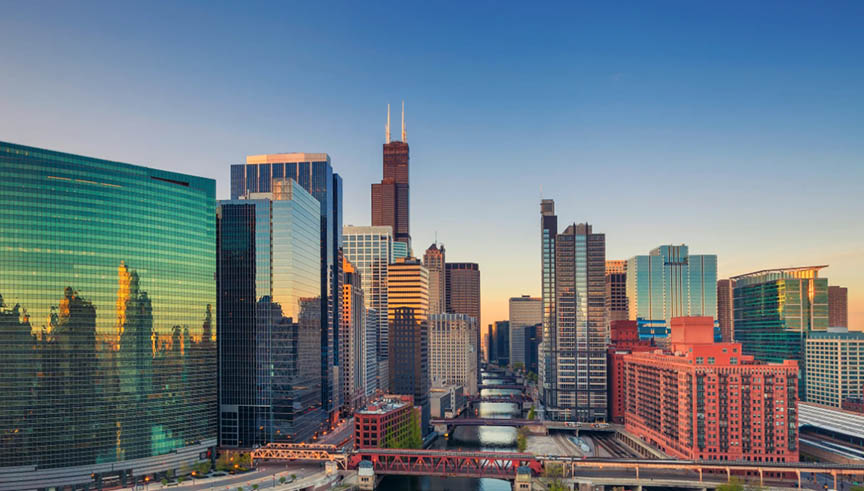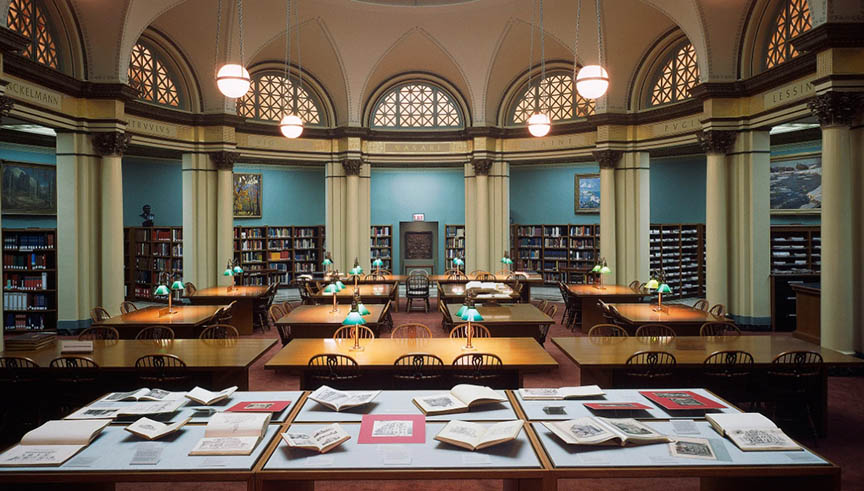
Skyscraping Marvels: The Astonishing Architectural Beauty of Downtown Chicago
Embarking on an exploration through Chicago’s cityscape, I found myself amidst a stunning array of towering skyscrapers, each telling a unique tale of architectural brilliance.
Willis Tower (Formerly Sears Tower)
Location: 233 S Wacker Dr, Chicago, IL 60606
Ascending the Willis Tower, a historical monument that once claimed the title of the world’s tallest building, was a surreal experience that unfolded as a highlight of my journey through Chicago. The climb promised unparalleled panoramic views of the city, setting the stage for a captivating exploration of its architectural and urban splendor.
Reaching the 103rd floor, I entered the Skydeck, a platform designed to offer an elevated perspective of Chicago’s sprawling landscape. The glass-floored ledge, an audacious architectural feature, introduced a thrilling dimension to the experience, providing a heart-pounding view straight down to the city below. Stepping onto the transparent surface was a moment of both excitement and trepidation, as the vast drop beneath my feet added an exhilarating edge to the encounter.
The cityscape unfurled before me in a mesmerizing display, with towering skyscrapers punctuating the skyline and the sinuous curves of the Chicago River weaving through the urban expanse. The architectural magnificence of the Willis Tower, set against the backdrop of the city’s diverse structures, created a visual symphony that celebrated Chicago’s unique blend of history and modernity.
Standing at the pinnacle of this iconic tower, the sense of being enveloped by the city’s dynamic energy was palpable. The experience not only showcased the architectural prowess of the Willis Tower but also allowed me to immerse myself in the city’s narrative, written in the language of its skyline.
The Skydeck, with its daring design and breathtaking views, became a focal point of my Chicago exploration, leaving an indelible mark on my memory. It encapsulated the essence of the city – a place where architectural innovation meets urban vitality. The Willis Tower, once a towering achievement in the world of skyscrapers, became a conduit for me to connect with Chicago’s past, present, and the soaring aspirations that define its skyline.
Pros: Breathtaking views, iconic stature, immersive Skydeck experience. Cons: Crowded during peak hours, admission fees apply.
Geographical Location: Dominating Chicago’s financial district, the Willis Tower is a prominent fixture visible from various points.
Getting There: Easily accessible by public transport and car, with nearby parking options. Entrance through the Skydeck on the ground floor.
Discounts and Reservations: Online reservations recommended for discounts and to bypass long queues.
The Art Institute of Chicago
Location: 111 S Michigan Ave, Chicago, IL 60603
Situated at 111 S Michigan Ave, Chicago, IL 60603, The Art Institute of Chicago unfolded before me as an enchanting voyage where the realms of art and architecture seamlessly intertwined. This cultural sanctuary, a beacon of creativity, beckoned me into a world where the past, present, and future of human expression converged in a mesmerizing tapestry.
The institute emerged as a custodian of an expansive and diverse collection that spanned the annals of time and embraced a myriad of cultures. Navigating through its halls, I found myself captivated by a kaleidoscope of artistic wonders – from ancient artifacts whispering tales of civilizations to contemporary masterpieces pushing the boundaries of imagination.

What truly set The Art Institute apart was not just the sheer volume of its treasures but the architectural symphony that played as a backdrop to these masterworks. The seamless fusion of historical and modern elements in the institute’s design created an ambiance that heightened the appreciation of the artwork. Ornate archways coexisted harmoniously with sleek contemporary spaces, forming a dynamic visual narrative that mirrored the evolution of artistic expression.
The institute’s allure extended beyond its walls, spilling into tranquil gardens that enveloped the surroundings. These outdoor sanctuaries, adorned with carefully curated greenery and art installations, served as an oasis for contemplation. The gardens became a seamless extension of the cultural experience, offering moments of repose and reflection amid the natural beauty that complemented the artistic riches within.
As I delved into the museum’s offerings, the architectural fusion and curated outdoor spaces added a layer of sophistication to the overall experience. The Art Institute of Chicago ceased to be a mere repository of art; it metamorphosed into a living testament to the enduring connection between creativity and design. This cultural gem, with its meticulous curation and architectural charm, embodied Chicago’s dedication to fostering a profound appreciation for the arts. Each visit became a symphonic exploration, a harmonious dance between the tangible and intangible elements that define human ingenuity.
Pros: Diverse art collection, striking architecture, serene gardens. Cons: Requires ample time for exploration due to its size.
Geographical Location: Nestled along Michigan Avenue, The Art Institute stands as a central cultural hub near Millennium Park.
Getting There: Conveniently reached on foot from downtown hotels or via public transport. Multiple entrances facilitate easy access.
Discounts and Reservations: Opt for online reservations, especially during peak hours, with available student and group discounts.
John Hancock Center (360 Chicago)
Location: 875 N Michigan Ave, Chicago, IL 60611
Ascending the heights of the John Hancock Center, strategically positioned at 875 N Michigan Ave, Chicago, IL 60611, to partake in the wonders of 360 Chicago unfolded as a sensory odyssey, offering a distinctive and unparalleled perspective of the city’s sprawling skyline. This expedition became a captivating exploration, where architectural marvels and urban vistas intertwined.
Reaching the pinnacle on the 94th floor, the much-anticipated TILT platform awaited, an architectural innovation that dared to defy gravity. Stepping onto this outward-projecting marvel was nothing short of exhilarating, as the cityscape below appeared to stretch infinitely, creating a blend of excitement and awe as the horizon dramatically tilted downward.
The 360-degree views from this elevated platform were nothing short of breathtaking. Iconic landmarks, the intricate urban landscape, and the meandering Chicago River painted a vivid tapestry of the city’s vibrant character. Whether during the golden hues of sunset or the twinkling lights of the city at night, the panorama added an enchanting layer to the visual spectacle.
Enhancing the experience were interactive exhibits that delved into the architectural evolution of the city, spotlighting notable landmarks and unraveling the stories woven into its skyline. For aficionados of architecture and skyline enthusiasts, this immersive encounter became an indispensable facet of exploration, offering a deeper understanding of Chicago’s growth and metamorphosis over time.
What set 360 Chicago apart was its ability to engage visitors on multiple levels. It transcended the traditional concept of observation decks by seamlessly blending cutting-edge architecture, panoramic views, and educational exhibits. The experience wasn’t just about observing the city; it was about becoming an integral part of its narrative.
Pros: Spectacular views, TILT experience, interactive exhibits. Cons: Higher admission fees, occasional wait times for TILT.
Geographical Location: Nestled along the Magnificent Mile, the John Hancock Center is a defining structure in the Gold Coast neighborhood.
Getting There: Accessible via public transport, with parking options nearby. Elevators from the lobby swiftly transport visitors to the observation deck.
Discounts and Reservations: Online bookings come with discounts, and it’s advisable to secure tickets in advance.
Recommended Gems
The Chicago Riverwalk
Location: Along the Chicago River, downtown area
The Riverwalk serves as a hidden oasis amidst the urban hustle, offering a picturesque setting for a leisurely stroll or riverside dining. Lined with cafes and art installations, it provides a serene escape with the city’s architectural wonders as a backdrop.

Getting There: Accessible on foot from downtown hotels or by taking a water taxi along the Chicago River.
Special Tips: Sunset visits offer a breathtaking view as city lights reflect on the river.
Maggie Daley Park
Location: 337 E Randolph St, Chicago, IL 60601
Maggie Daley Park is a dynamic urban retreat within the Loop. The park’s unique architecture, including the Ribbon ice-skating ribbon and Play Garden, blends seamlessly with recreational spaces and stunning skyline views.
Getting There: A short walk from Millennium Park or reachable by public transport.
Special Tips: Winter visits allow for an enchanting ice-skating experience against the cityscape.
Chicago Cultural Center
Location: 78 E Washington St, Chicago, IL 60602
The Chicago Cultural Center, a historical architectural gem, houses a rich array of artistic and cultural experiences. The Tiffany Dome, intricate mosaics, and rotating art exhibitions make it a haven for art enthusiasts, set within a captivating Beaux-Arts structure.
Getting There: Centrally located in the Loop, accessible on foot or by public transport.
Special Tips: Check the schedule for free cultural events and concerts frequently held at the center.
The Rookery Building
Location: 209 S LaSalle St, Chicago, IL 60604
The Rookery Building stands as an architectural masterpiece seamlessly blending historic and modern elements. Designed by Burnham and Root, the atrium and Frank Lloyd Wright’s lobby renovation showcase Chicago’s architectural evolution.
Getting There: Positioned in the financial district, accessible by public transport or on foot.
Special Tips: Opt for a guided tour to delve into the building’s history and architectural significance.
Chicago’s downtown skyline, adorned with architectural marvels, offers a visual symphony that captivates the soul. From the towering heights of the Willis Tower to the cultural richness of The Art Institute, each landmark tells a story of innovation, creativity, and the city’s dynamic spirit.
You May Also Like

Shopping Extravaganza: Exploring Hong Kong’s Premier Retail Districts
20/01/2024
Luxurious Delight: The Pinnacle of Accommodation in Wanaka
05/10/2023

